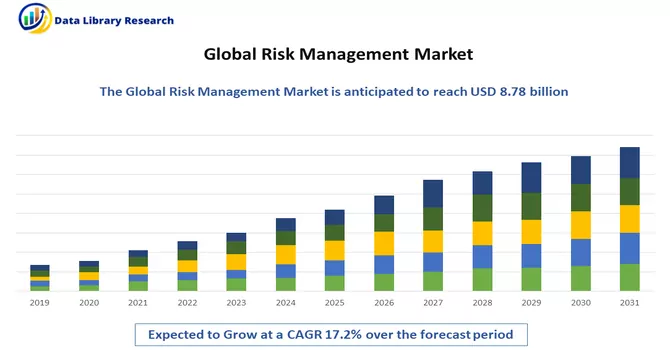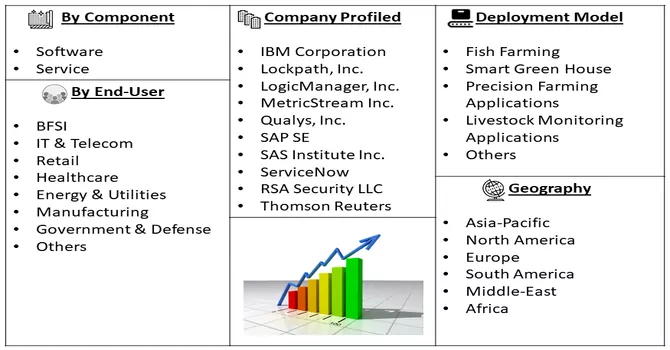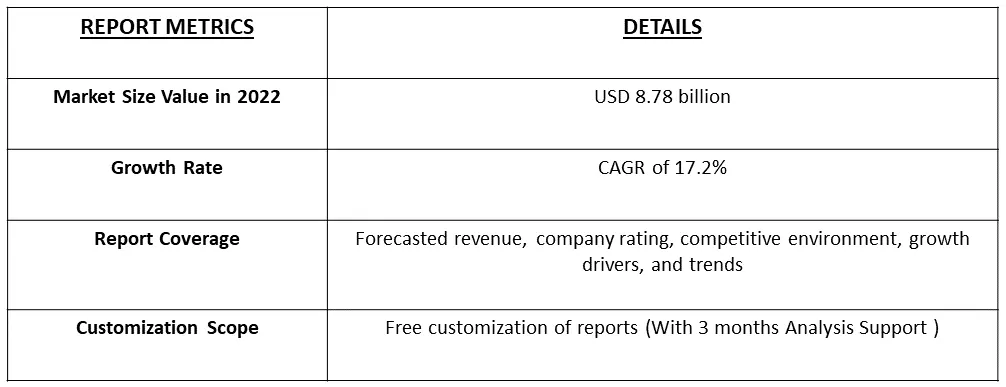The Risk Management Market was currently valued at USD 8.78 billion in the year 2022, registering a CAGR of 17.2% over the forecast period, 2023-2030.

Get Complete Analysis Of The Report - Download Free Sample PDF
Risk management is the identification, evaluation, and prioritization of risks followed by the coordinated and economical application of resources to minimize, monitor, and control the probability or impact of unfortunate events or to maximize the realization of opportunities.
The key objective of risk management software is to closely monitor and control different types of risks, which an organization faces due to various types of compliances. The main purpose of the software is to identify risk, reduce its impact, and efficiently manage it. In addition, numerous benefits, such as efficient decision-making, realistic expectations, escalation, and focus on risk, associated with risk management software are the lucrative factors that boost market growth.
The latest trends in the global risk management market trends include a surge in data security breaches in enterprises and an increase in stringent government regulatory compliances across the globe are the key factors that drive the growth of the global risk management market. In addition, the rise in the adoption of risk management in FinTech industries and growth in the IoT landscape across the globe positively impacts the growth of the market.
Segmentation:
The Risk Management Market is Segmented
By Component
Deployment Model
Industry Vertical
Geography
The report offers the value (in USD million) for the above segments.

For Detailed Market Segmentation - Download Free Sample PDF
Drivers:
Increase in Stringent Government Regulatory Compliances Regulatory compliance is an organization's adherence to laws, regulations, guidelines, and specifications relevant to its business processes. Violations of regulatory compliance often result in legal punishment, including federal fines. Compliance has become increasingly important as it can prevent legal issues, maintain a company’s reputation, retain employees, improve company culture, and increase productivity. For instance, the Singapore government has introduced a new regulatory framework that uses civil and criminal measures for financial benchmark manipulation. Moreover, according to a study conducted in China, the government of China implemented GRC (governance, risk management, and compliance management) solutions in organizations to improve risk monitoring, segregation of Duties (SOD) management reporting, and continuous control monitoring (CCM). As a result, these different regulations imposed by governments in different countries have provided a lucrative opportunity for the risk management market in recent years.
Growing Complexities Across Business Processes
The increased usage of large amounts of structured and unstructured data in the various end-user industries boosts the demand for risk analytics to manage and save data from threats. For instance, Seagate Technology PLC, the global volume of data is expected to increase to 47 zettabytes and 163 zettabytes in 2020 and 2025. Moreover, cloud computing is driving a software revolution astonishingly as any other computing revolution of the past 40 years. As analytics for location-based risk advance, it is only sensible that they can be built and delivered using cloud-based technology rather than older server-based systems. There are several risk assessment and accumulation platforms available now through the cloud. Rules-based approaches to security, whether they are applied to threat detection, investigation, or response, can no longer keep pace with advanced cyber threats, including account compromise and malicious insiders.
Restraints:
High Cost and Complexity in Installation and Configuration of the Software
Software maintenance is a critical part of the software development life cycle (SDLC) and is necessary for risk management to ensure that the software continues to meet the needs of the users over time. The maintenance, installation, and configuration of software require a large investment and it is a cost-driven process and this may slow down the growth of the market over the forecast period.
The emergence of COVID-19 is expected to have a considerable impact on the growth of the risk management market. The spending on the risk management software industry is expected to increase as compared to spending planned before this pandemic, owing to multiple factors such as growth in work-from-home culture among industries and a rise in the risk of cyber-attacks and other security issues. Furthermore, the COVID-19 pandemic has brought radical changes to the daily lives of people, work, and the surrounding environment. The risk management market growth is expected to recover from the end of 2020; however, it is expected to grow significantly at a higher CAGR in the coming years, owing to work-from-home (WFH), social distancing, and digital transformation of businesses. These factors have become key components in the emergence of business messaging as an ideal channel to communicate with consumers.
The Russian-Ukrainian War also significantly impacted the growth of the market by causing mismanagement in the supply chain and thus market faced significant challenges.
Segmental Analysis
Software Segment is Expected to Witness Significant Growth Over the Forecast Period
The software mainly aims to protect and secure individual computing devices, information systems, internet communication, transactions, and networks. Security software performs tasks, such as access management, data & and network protection, as well as security against viruses, intrusions, and any other system-level security risks. The demands of remote working have increased expenditure on cybersecurity software.
Cloud Based Deployment System Segment is Expected to Witness Significant Growth Over the Forecast Period
Cloud computing is the provision of computing resources and services from the internet (“the cloud”) on an on-demand basis as opposed to using one’s own server infrastructure and hardware. Cloud computing makes it possible to use vast data storage, powerful servers, high bandwidth networking, remote databases, and software over the internet at exponentially lower costs.
Healthcare Segment By Industrial Vertical is Expected to Witness Significant Growth Over the Forecast Period
The usage of the internet and the digitalization of healthcare processes have become essential for developing a better understanding of healthcare information technologies and their impact on health communication. Additionally, the high adoption of healthcare IT by hospitals is driven by the advantages, such as ease of use and saving time, labor, and space. The continuous upgradation of the solutions provided by the market players to better benefit the users is also propelling the growth of this segment.
North America is Expected to Hold a Significant Share in the Studied Market Over the Forecast Period
North America is expected to hold the highest market share, with the United States leading the market. The dominance of the region is due to its increasing adoption of risk analytics solutions among end-user industries, a significant presence of large enterprises, and drive for early technological adoption owing to competition from other businesses operating in low-cost regions. Additionally, there have been 28 data breach incidents reported during the pandemic year in the United States, including email hacking incidents, malware attacks, and unauthorized access to EHRs (source the US Department of Health & Human Services). In the medical healthcare sector, cloud computing is considered to be an immediate remedy because it is scalable as well as economical. Thus, due to such reasons, the market is expected to witness significant growth over the forecast period in the region.

Get Complete Analysis Of The Report - Download Free Sample PDF
Competitive Analysis:
The Risk Management Market is highly competitive due to the presence of many market players working globally and regionally in this market segment. These players have adopted various strategies to increase their market penetration and strengthen their foothold in the risk management market industry. Some of the key players operating in the global risk management market industry include:
Recent Developments
1) November 2022: As the business expands, New York-based MGA Elpha Secure teamed with CyberCube to use two of its cyber risk analytics tools to make a strong case for capacity from suppliers active in the ILS market.
2) November 2022: Synspective, a provider of synthetic aperture radar (SAR) satellite data and solutions, and Geo Climate Risk Solutions Pvt. Ltd. (GCRS), a solution provider, consultancy, and advisory services firm that focuses on natural hazards risk analytics and environmental and sustainability challenges are happy to announce a new partnership for SAR-based analysis solutions for critical infrastructure and mining industries in India and throughout South Asia. GCRS and Synspective will collaborate to offer risk analysis solutions for the mining and critical infrastructure sectors to speed up regional net-zero projects.
Q1. What is the current Risk Management Market size?
The Risk Management Market was currently valued at USD 8.78 billion.
Q2. What is the Growth Rate of the Risk Management Market ?
Risk Management Market is registering a CAGR of 17.2% over the forecast period.
Q3. What segments are covered in the Risk Management Market Report?
By Component, By Deployment Model, By Industry Vertical and Geography are the segments are covered in the Risk Management Market Report.
Q4. Which region has the largest share of the Risk Management Market? What are the largest region's market size and growth rate?
North America has the largest share of the market . For detailed insights on the largest region's market size and growth rate request a sample here.
Data Library Research are conducted by industry experts who offer insight on industry structure, market segmentations technology assessment and competitive landscape (CL), and penetration, as well as on emerging trends. Their analysis is based on primary interviews (~ 80%) and secondary research (~ 20%) as well as years of professional expertise in their respective industries. Adding to this, by analysing historical trends and current market positions, our analysts predict where the market will be headed for the next five years. Furthermore, the varying trends of segment & categories geographically presented are also studied and the estimated based on the primary & secondary research.
In this particular report from the supply side Data Library Research has conducted primary surveys (interviews) with the key level executives (VP, CEO’s, Marketing Director, Business Development Manager and SOFT) of the companies that active & prominent as well as the midsized organization
FIGURE 1: DLR RESEARH PROCESS

Extensive primary research was conducted to gain a deeper insight of the market and industry performance. The analysis is based on both primary and secondary research as well as years of professional expertise in the respective industries.
In addition to analysing current and historical trends, our analysts predict where the market is headed over the next five years.
It varies by segment for these categories geographically presented in the list of market tables. Speaking about this particular report we have conducted primary surveys (interviews) with the key level executives (VP, CEO’s, Marketing Director, Business Development Manager and many more) of the major players active in the market.
Secondary ResearchSecondary research was mainly used to collect and identify information useful for the extensive, technical, market-oriented, and Friend’s study of the Global Extra Neutral Alcohol. It was also used to obtain key information about major players, market classification and segmentation according to the industry trends, geographical markets, and developments related to the market and technology perspectives. For this study, analysts have gathered information from various credible sources, such as annual reports, sec filings, journals, white papers, SOFT presentations, and company web sites.
Market Size EstimationBoth, top-down and bottom-up approaches were used to estimate and validate the size of the Global market and to estimate the size of various other dependent submarkets in the overall Extra Neutral Alcohol. The key players in the market were identified through secondary research and their market contributions in the respective geographies were determined through primary and secondary research.
Forecast Model
